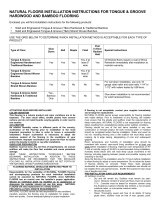
QuietR
®
Duct Board
Installation Instructions
Pub No. 10021561. Printed in U.S.A. September 2016. © 2016 Owens Corning. All Rights Reserved.
Installation
Fabrication and installation of fi ber glass Duct Systems shall be in accordance with the UL listing and shall conform to
Owens Corning’s published methods and/or latest editions of NAIMA (North American Insulation Manufacturers Association)
Fibrous Glass Duct Construction Standards or SMACNA (Sheet Metal and Air Conditioning Contractors National
Association) Fibrous Glass Duct Construction Standards. One of the following closure methods must be employed to meet
the requirements of UL 181/ULC S110. USE OF A NON-LISTED CLOSURE SYSTEM VOIDS THE UL CLASS 1 AIR DUCT
RATING.
1. Pressure-Sensitive Tape
Any tape listed and labeled under UL 181A, Part I (P).
a. All longitudinal and circumferential joints must be stapled with outward fl aring ½ " (13mm) (min.) staples, 2" (50mm)
(approx.) O.C.
b. Wipe surface where tape is to be applied to fi eld joints with clean cloth. If surface has grease or oil, saturate cloth
with approved solvent. Refer to tape manufacturer’s recommendations.
c. Center tape over edge of stapling fl ap and rub fi rmly in place immediately after application, using a squeegee or similar
tool.
d. A heat sealing iron must be used to assure a good bond when installed below 50°F (10°C).
e. Tape should not be applied to surface of duct board when temperature is below 32°F (0°C) due to the possibility of
entrapping ice crystals which will cause tape to loosen upon melting. Heat surface fi rst to drive off moisture.
2. Heat-Activated Tape
Any tape listed and labeled under UL 181A,Part II (H).
a. All longitudinal and circumferential joints must be stapled with outward fl aring ½ " (13mm) (min.) staples, 2" (50mm)
(approx.) O.C.
b. Wipe surface where tape is to be applied with clean cloth. If surface has grease or oil, saturate cloth with approved
solvent. Refer to tape manufacturer’s recommendations.
c. Center tape over joint and seal down tape end with 500°F (260°C) iron. Do not use heat gun; heat and pressure are
both required to effect a seal.
d. Press down entire length of tape to hold in place using a smearing action to get good bond. Colored dots on tape
surface darken when satisfactory bonding temperature is reached.
e. Staples may be omitted when automatic closure machines such as Glass Master Closemasters are used. Iron
temperature must be set at 650°F (343°C) minimum. Continuous production may require periodic pauses to allow
sealing iron to recover to 650°F (343°C).
f. Allow joint to cool before stressing.
3. Mastic and Glass Fabric
Any mastic and glass fabric closure system listed and labeled under UL 181, Part III (M).
a. All longitudinal and circumferential joints must be stapled with outward fl aring ½ " (13mm) (min.) staples, 2" (50mm)
(approx.) O.C.
b. Brush mastic onto joint and embed glass fabric in mastic.
c. Brush second coat of mastic over fabric until completely fi lled.
d. Allow joints to dry in accordance with mastic manufacturer’s recommendation before pressurizing system.
Tips to Avoid Mold Growth in Ducts
Mold in duct systems occurs when moisture comes into contact with dirt or dust collected on the duct system surfaces.
Proper fi lters will minimize the collection of dust and dirt, but care needs to be exercised to prevent water formation in the
duct. A properly sized and operated air conditioning unit will minimize the likelihood of water formation.
The system must be maintained and operated to insure that suffi cient dehumidifi cation is occurring and that fi lters are installed
and changed as recommended by the equipment manufacturer.
/






